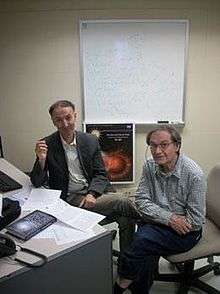Vahe Gurzadyan
| Vahe Gurzadyan | |
|---|---|
 | |
| Born |
21 November 1955 Yerevan |
| Nationality | Armenian |
| Fields | mathematical physicist |
Vahagn "Vahe" Gurzadyan (Armenian: Վահագն Գուրզադյան, born November 21, 1955) is an Armenian mathematical physicist and a professor and head of Cosmology Center at Yerevan Physics Institute, Yerevan, Armenia, best known for co-writing "Concentric circles in WMAP data may provide evidence of violent pre-Big-Bang activity" [1] paper with his colleague Roger Penrose, and collaborating on Roger Penrose's recent book Cycles of Time. Gurzadyan was born in Yerevan, Armenia (then USSR) in 1955, November 21. Graduated Yerevan State University (1977), postgraduate student in Theoretical Physics department, Lebedev Physics Institute, Moscow (1977–1980; 1980 PhD.), DSci in Theoretical and mathematical physics (1988).
In 1989 he lectured on dynamical systems in 4 Universities in Japan. Held visiting positions in several Universities: University of Sussex (1996–1997) and since 2001 in University of Rome "Sapienza". His father Grigor Gurzadyan is an Armenian astronomer, pioneer of space astronomy. His grandfather Ashkharbek Kalantar is a Russian Empire and Armenian archaeologist and historian, Fellow of Russian Imperial Archaeological Society and the keeper of the Asiatic Museum in St. Petersburg.[2]
The main topics of his research: chaos in non-linear systems, accretion onto massive black holes, stellar dynamics, observational cosmology. Has published 2 monographs, 150 articles, edited 6 books.
Prediction of elliptical accretion disks in galactic nuclei

Gurzadyan has papers predicting elliptical accretion disks formed in galactic nuclei at tidal disruption of stars near massive black holes;[3] much later tidal mechanism has been associated to the flares observed in AGN.[4]
Chaos in galaxies
He has shown (with Savvidy) the exponential instability (chaos) in spherical stellar systems and has derived the collective relaxation time.[5][6][7] Has formulated a list of 10 key problems in stellar dynamics [8][9] [10]
Voids
Cosmic microwave background indications for voids - large scale underdense regions - were obtained by Gurzadyan et al., including on the void nature of the Cold Spot,[11][12] confirmed by independent galaxy survey,[13] as of possibly largest known structure in the Universe.
Testing light speed isotropy and Lorentz invariance
Gurzadyan has suggested and initiated the use of Compton Edge method for high accuracy testing of the light speed isotropy and the Lorentz invariance at GRAAL experiment in European Synchrotron Radiation Facility (Grenoble); the obtained limit became a reference number for Special Relativity extension models.[14][15][16][17]
Information panspermia
Gurzadyan coined [18] the concept of information panspermia which Webb [19] attributed as Solution 23 of Fermi Paradox. That concept includes the hypothesis that the Universe can be full of traveling extraterrestrial life streams as low-complexity compressed bit strings at von Neumann automata network. Gurzadyan has shown that human genome and hence the terrestrial life possess low Kolmogorov complexity and hence the corresponding bit strings can be transmitted by Arecibo-type antenna to Galactic distances.
Gurzadyan and Penrose discussed information panspermia [20] within the Conformal Cyclic Cosmology, and the cosmic microwave background radiation transferring information from pre-Big Bang aeon to ours.
Revealing the chronology of ancient world with astronomical dating
Gurzadyan's collaboration with archaeologists on the Chronology of the ancient Near East[21] and his analysis of the Venus tablet of Ammisaduqa and of lunar eclipses of 3rd dynasty of Ur led to the introducing of the Ultra-Low chronology of the 2nd-millennium ancient Near East.[22] He identified the Halley's comet depicted on ancient coins of Armenian king Tigranes the Great, I c.BC. as the earliest known image of that comet[23] He revealed the observation of supernova SN 1054 (progenitor of Crab nebula) in Armenian medieval chronicle of Hetum (Hayton of Corycus) and Cronaca Rampona.[24]
Other impacts
He led a study with geneticists in Duke University introducing a new method to detect somatic mutations in genomic sequences,[25] in proposing bath-quantum system viewpoint on the relation of thermodynamic and cosmological arrows of time.[26]
Activities
Member of Euroscience Governing Board (elected in 1998, reelected in 2002). Chair of Scientific Organizing Committee of workshop "Ergodic Concepts in Stellar Dynamics", Geneva, 1993; Local Organizing Committee of workshops "The Chaotic Universe", Rome, 1999; “Fermi and Astrophysics”, Rome-Pescara, 2001; IX Marcel Grossmann meeting, Rome 2000. Chair of 'Chaos' Parallel sessions at Marcel Grossmann Meetings, Jerusalem, 1997, Rome, 2000, Rio de Janeiro, 2003, Berlin, 2006. Paris, 2009. Co-editor of Intern.Journ.Modern Phys D (World Scientific, 2000-2010), of The European Physical Journal Plus (Springer) and of book series 'Advances in Astronomy and Astrophysics' (Taylor & Francis, UK). Fellow of the Royal Astronomical Society (UK).
Speaker at XXII Solvay conference on physics, keynote speaker at IXth Swiss Biennial on Science, Technics + Aesthetics on “The Large, The Small and the Human Mind”, lecturer at Xth Brazilian School of Cosmology and Gravitation.
Articles
His article "Kolmogorov and Aleksandrov in Sevan Monastery, Armenia, 1929" was published in The Mathematical Intelligencer in October 2004.[27] [28][29]
References
- ↑ Gurzadyan, V.G.; Penrose, R. (2013). "On CCC-predicted concentric low-variance circles in the CMB sky". Eur.Phys.J. Plus. 128: 22. doi:10.1140/epjp/i2013-13022-4.
- ↑ http://ysu.am/gender/en/The-bust-of-Ashkharbek-Kalantar-was-placed-at-YSU
- ↑ Gurzadyan, V.G.; Ozernoy, L.M. (1979). "Accretion on massive black holes in galactic nuclei". Nature. 280 (5719): 214–215. doi:10.1038/280214a0.
- ↑ Komossa, S. (2015). "Tidal disruption of stars by supermassive black holes: Status of observations". J. High Energy Astrophys. 7: 148–157. doi:10.1016/j.jheap.2015.04.006.
- ↑ Gurzadyan, V.G.; Savvidy, G.K. (1986). "Collective relaxation of stellar systems". Astron. Astrophys. 160: 203.
- ↑ Gurzadyan, V.G.; Kocharyan, A.A. (2009). "Collective relaxation of stellar systems revisited". Astron. Astrophys. 505: 625–627. Bibcode:2009A&A...505..625G. doi:10.1051/0004-6361/200912218.
- ↑ Vesperini, E (1992). "Possible observational indication for Gurzadyan-Savvidy relaxation for globular clusters". Astron. Astrophys. 266: 215.
- ↑ Gurzadyan V.G., Pfenniger D., Eds., Ergodic Concepts in Stellar Dynamics, Lecture Notes in Physics, vol.430, Springer, 1994. http://arxiv.org/abs/1407.0398
- ↑ Eingorn, M. (2014). "Gurzadyan's Problem 5 and improvement of softenings for cosmological simulations using the PP method". Adv. High Energy Phys. 2014: 903642; . doi:10.1155/2014/903642.
- ↑ Gurzadyan, V.G.; Harutyunyan, V.V.; Kocharyan, A.A. (2015). "A principal possibility for computer investigation of evolution of dynamical systems with independent on time accuracy". European Physical Journal C. 75: 252. doi:10.1140/epjc/s10052-015-3479-5.
- ↑ Gurzadyan, V.G.; Kocharyan, A.A. (2009). "Porosity Criterion for Hyperbolic Voids and CMB". Astron. Astrophys. 493: L61–63. doi:10.1051/0004-6361:200811317.
- ↑ Gurzadyan, V.G.; et al. (2014). "To the center of cold spot with Planck". Astron. Astrophys. 566: A135. doi:10.1051/0004-6361/201423565.
- ↑ Szapudi, I.; et al. (2015). "Detection of a supervoid aligned with the cold spot of the cosmic microwave background". Monthly Notices of the Royal Astronomical Society. 450: 288. doi:10.1093/mnras/stv488.
- ↑ Gurzadyan, V. G.; Margarian, A. T. (1996). "Inverse compton testing of fundamental physics and the cosmic background radiation". Physica Scripta. 53: 513–515. Bibcode:1996PhyS...53..513G. doi:10.1088/0031-8949/53/5/001.
- ↑ Gurzadyan V.G.; et al. (2007). "Lowering the light speed isotropy limit: European Synchrotron Radiation Facility measurements". Il Nuovo Cimento. B122: 515. arXiv:astro-ph/0701127
 . Bibcode:2007NCimB.122..515G.
. Bibcode:2007NCimB.122..515G. - ↑ Gurzadyan V.G.; et al. (2012). "A new limit on the light speed isotropy from the GRAAL experiment at the ESRF". Proc. 12th M.Grossmann Meeting on General Relativity. B: 1495. arXiv:1004.2867
 . Bibcode:2010arXiv1004.2867G. doi:10.1142/9789814374552_0255.
. Bibcode:2010arXiv1004.2867G. doi:10.1142/9789814374552_0255. - ↑ Bocquet J-P.; et al. (2010). "Limits on light-speed anisotropies from Compton scattering of high-energy electrons". Physical Review Letters. 104 (24): 24160. arXiv:1005.5230
 . Bibcode:2010PhRvL.104x1601B. doi:10.1103/PhysRevLett.104.241601.
. Bibcode:2010PhRvL.104x1601B. doi:10.1103/PhysRevLett.104.241601. - ↑ Gurzadyan, V.G. (2005). "Kolmogorov complexity, string information, panspermia and the Fermi paradox". Observatory. 125: 352.
- ↑ Webb, S. (2015). "If the Universe Is Teeming with Aliens ... Where is Everybody? Seventy-Five Solutions to the Fermi Paradox and the Problem of Extraterrestrial Life". Springer. 53: 53–1258. doi:10.5860/choice.193286.
- ↑ Gurzadyan, V.G.; Penrose, R. (2016). "CCC and the Fermi paradox". Eur. Phys. J. Plus. 131: 11. doi:10.1140/epjp/i2016-16011-1.
- ↑ Gasche, H., Armstrong, J.A., Cole, S.W. and Gurzadyan, V.G., Dating the fall of Babylon: A Reappraisal of Second-millennium Chronology, University of Ghent and the Oriental Institute of the University of Chicago,1998.
- ↑ Gurzadyan V.G., "On the Astronomical Records and Babylonian Chronology", Akkadica, v.119-120, p.175 (2000); Gurzadyan V.G., "The Venus Tablet and refraction.", Akkadica v.124, p.13 (2003); Gurzadyan V.G., Astronomy and the Fall of Babylon, Sky & Telescope, v.100, No.1 (July), p.40 (2000); Gurzadyan V.G., Warburton D.A., On the Available Lunar and Solar Eclipses and Babylonian Chronology, Akkadica, v.126, p.195 (2005).
- ↑ Gurzadyan, V. G.; Vardanyan, R. (2004). "Halley's comet of 87 BC on the coins of Armenian king Tigranes?". Astronomy & Geophysics. 45: 4.06. doi:10.1046/j.1468-4004.2003.45406.x.
- ↑ Gurzadyan, V.G. (2012). "The supernova of 1054 AD, the Armenian chronicle of Hetum, and Cronaca Rampona". Observatory. 132: 338–339. Bibcode:2012Obs...132..338G.
- ↑ Gurzadyan, V. G.;; et al. (2015). "Detecting somatic mutations in genomic sequences by means of Kolmogorov–Arnold analysis". Royal Society Open Science. 2: 150143. doi:10.1098/rsos.150143.
- ↑ Allahverdyan, A.E.; Gurzadyan, V.G. (2002). "Arrows of Time and Chaotic Properties of the Cosmic Background Radiation". Journ. Phys. A35: 7243–7254. doi:10.1088/0305-4470/35/34/301.
- ↑ Gurzadyan, Vahe G. (2008). "Kolmogorov and Aleksandrov in Sevan Monastery, Armenia, 1929". The Mathematical Intelligencer. 26 (2): 40–43. doi:10.1007/BF02985651. ISSN 0343-6993.
- ↑ http://arxiv.org/abs/1011.3715
- ↑ http://hpj.asj-oa.am/1650/
External links
- http://cosmo.yerphi.am/
- http://www.amazon.com/s?ie=UTF8&page=1&rh=n%3A283155%2Cp_27%3AV%20G%20Gurzadyan
- http://arxiv.org/find/all/1/all:+Gurzadyan/0/1/0/all/0/1
- http://www.icra.it/People/Gurzadyan.htm
- http://www.nature.com/news/2010/101210/full/news.2010.665.html#B1